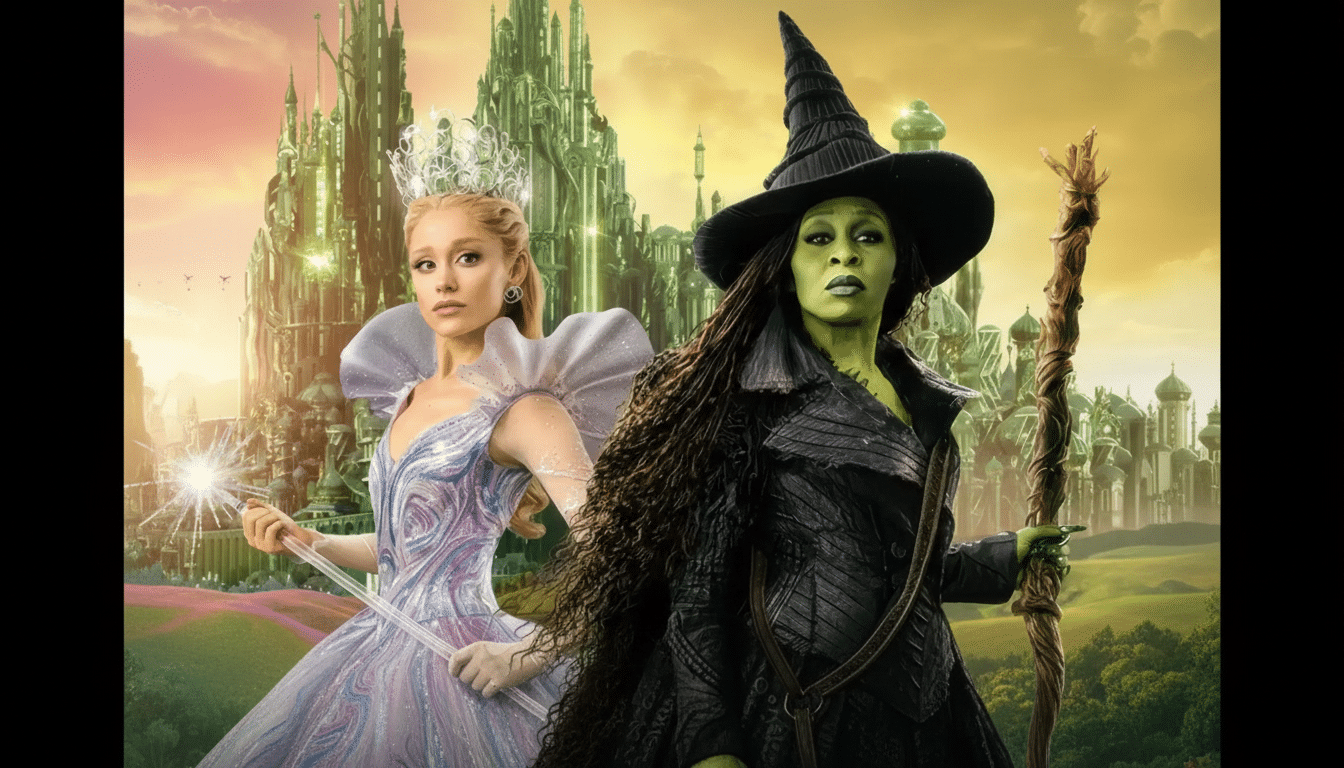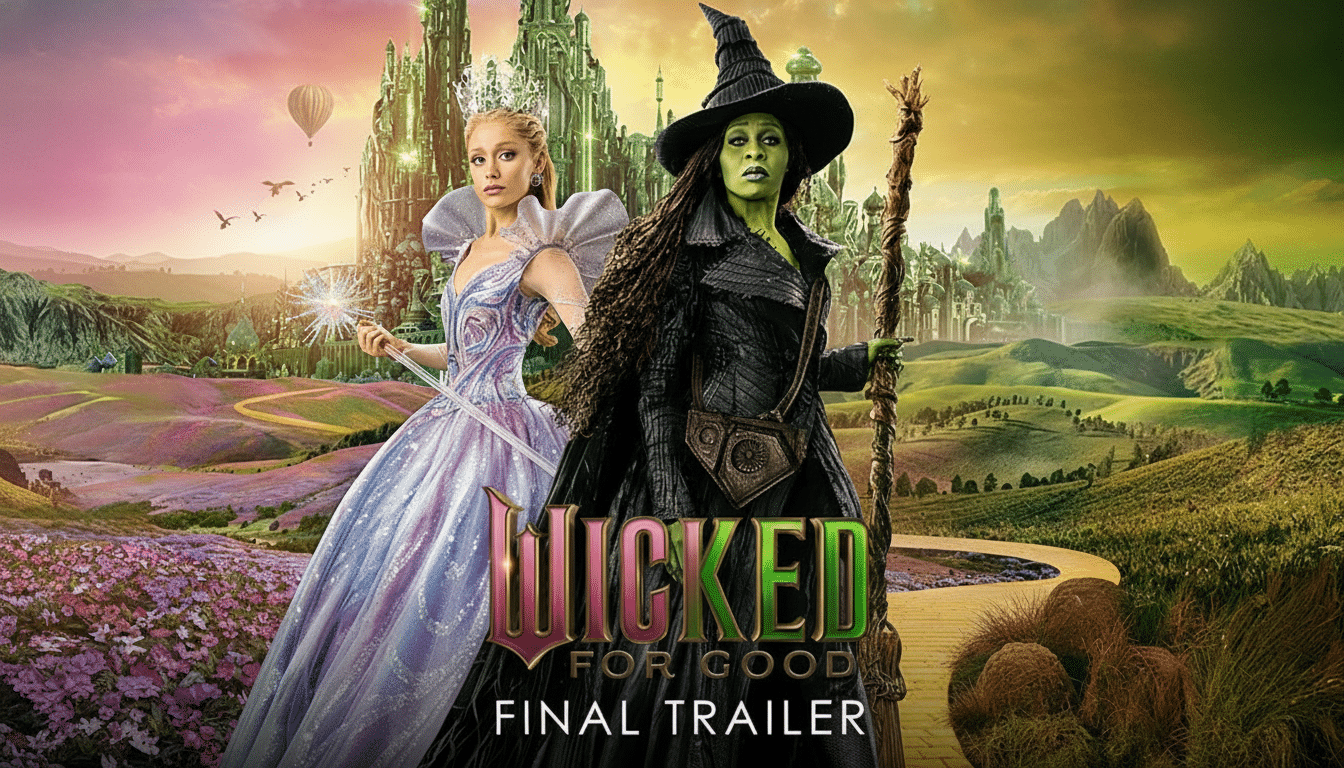Jon M. Chu’s two-parter bet sticks the landing. Wicked For Good brings Cynthia Erivo and Ariana Grande together for a socko finale that kicks out the jams, on which it sings with confidence, spectacle, and heart, to bring Oz’s bleakest chapter yet to the screen through a miasma of uncertainty the first film only gestured toward. The result is a rousing finale that should delight fans of the Broadway sensation and make new converts feel welcome to the party.
Erivo And Grande Turn Chemistry Into Fire
Elphaba, as played by Erivo, shows up fully formed — vocally volcanic, physically rooted, and emotionally sliced open. Her low register seethes; her high notes slice. If Part One pushed her to be a babe in the woods, against type, this chapter gives her control over scenes, dominating them with an intensity that once made her a stage sensation.

Grande answers with a smartly calibrated Glinda, playing up the bubble-bright humor without deflating the stakes. Yet she sews in comic beats with poignancy — a tossed-off gag one minute, a candor-laced confession the next — so that the character’s public glitter and private doubt genuinely coexist. Both performers get new numbers that deepen character interiority; neither outshines the show’s canonized hits, but both fit into the narrative architecture.
A Brighter Oz, Though With a Few False Steps
Where the first film’s palette was surprisingly muted, this sequel revels in saturation. Under Nathan Crowley’s production design and Paul Tazewell’s costumes, gemstone greens and blushing pinks luxuriate through the prism of power dynamics in a pure color story: Elphaba’s inky silhouette against Emerald City pomp says volumes before a lyric is sung.
Chu orchestrates a number of muscular set pieces — especially a rescue involving the Wizard’s grim Yellow Brick Road ventures — that deliver blockbuster scale without losing sight of the characters. The camera does sometimes return to those gray veils in passages late in the game, softening faces and flattening contrast at the precise moment when dramatic intensity is peaking. A brief de-aging flourish distracts more than it dazzles, an infrequent reminder of pixels trespassing on practical magic.
Story Beats Sharpened For The Big Screen
Winnie Holzman (adapting her book for Broadway) and Dana Fox turn some of Act Two’s busier turns into clean arcs for the screen. The Wizard’s propaganda machine (that businesses-are-people, weaponized-fear monster of a song) and its tactics for silencing Oz’s animals land with jolting immediacy, and the ripple effects across Elphaba’s fracturing bonds are deeply felt. Encounters with the old pals Nessa and Boq are explosions of consequence, and the rekindled flame with Fiyero contributes heat without completely usurping the plot.
Not every addition sings. A few flashbacks over-explain motivations that the performances already convey; they contribute to stitching up a two-movie structure, but sometimes stall momentum. But Chu’s nimble tonal gearshifts — say, for a hilariously petty witch-on-witch scuffle that’s more frenemies than fantasy warfare — keep the movie fleet and crowd-pleasing.

Ensemble Wins And Inspired Reimaginings Shine
Jeff Goldblum’s Wizard is courtly menace in a bespoke smile; Michelle Yeoh’s Madam Morrible gleefully wields decorum as a weapon. Jonathan Bailey transforms Fiyero into a rare romantic lead who actually changes on screen; his chemistry with Erivo snaps, and he remains charming even through a crucial shape-shifting. The Boq of Ethan Slater is unexpectedly sharp, and so chillingly precise is the Nessa of Marissa Bode.
Iconic Oz characters emerge with clever winks and new textures. A mix of makeup, costuming, and limited CG largely pays off; an otherwise prominently CG-driven creature comes across as less convincing (though a tremulous vocal performance by Colman Domingo gives the character some backbone). A short but sweet interlude from fan-favorite sidekicks (cue Bowen Yang and Bronwyn James) is darkly funny.
What This Finale Means For Wicked’s Legacy
Wicked the stage musical is already a behemoth (one of Broadway’s three longest-running shows and perennial top grosser, according to the Broadway League, with a cast recording that went platinum by RIAA standards). A faithful yet cinematic close matters not only for fans, but to the life of the property’s long tail: It puts a generation-defining score (literal and metaphoric) into the hands of new audiences while making the case that large-scale movie musicals are legit event-sized objects when pursued with conviction.
Chu’s case makes good on something box office analysts, including Comscore’s Paul Dergarabedian, have long noted about musicals that last: repeat viewing thrives at the nexus of narrative stakes, star power, and showstoppers. Wicked For Good stands on that shared ground. But despite some indulgences and quibbles of design, the film builds to an emotionally cohesive, vocally soaring conclusion — that is, it sends audiences out humming and maybe a little misty-eyed.
Ultimately, this finale does more than conclude a story; it recalibrates a soon-to-be classic. Erivo’s resolute gravity and Grande’s incandescent buoyancy make for a duet the camera cannot resist, and Oz — finally!

